Comparative Cultural Analysis: Aboriginal and Indian Societies
VerifiedAdded on 2020/10/05
|8
|1291
|141
Report
AI Summary
This report provides a comparative analysis of Australian Aboriginal and Indian cultures, utilizing the Seven Dimensions of Culture by Trompenaars and Hampden-Turner, and Hofstede's Six Cultural Dimensions. The introduction provides background on Aboriginal Australians and their historical context. The report then compares the two cultures across dimensions such as universalism vs. particularism, power distance, individualism, masculinity, uncertainty avoidance, long-term orientation, and indulgence. The analysis highlights key differences and similarities, such as the Aboriginal culture's emphasis on rules and the Indian culture's focus on relationships, along with varying scores on Hofstede's dimensions. The report concludes by summarizing the findings, emphasizing the value of these cultural dimensions in understanding the two societies. It also includes references to the sources used for the analysis.
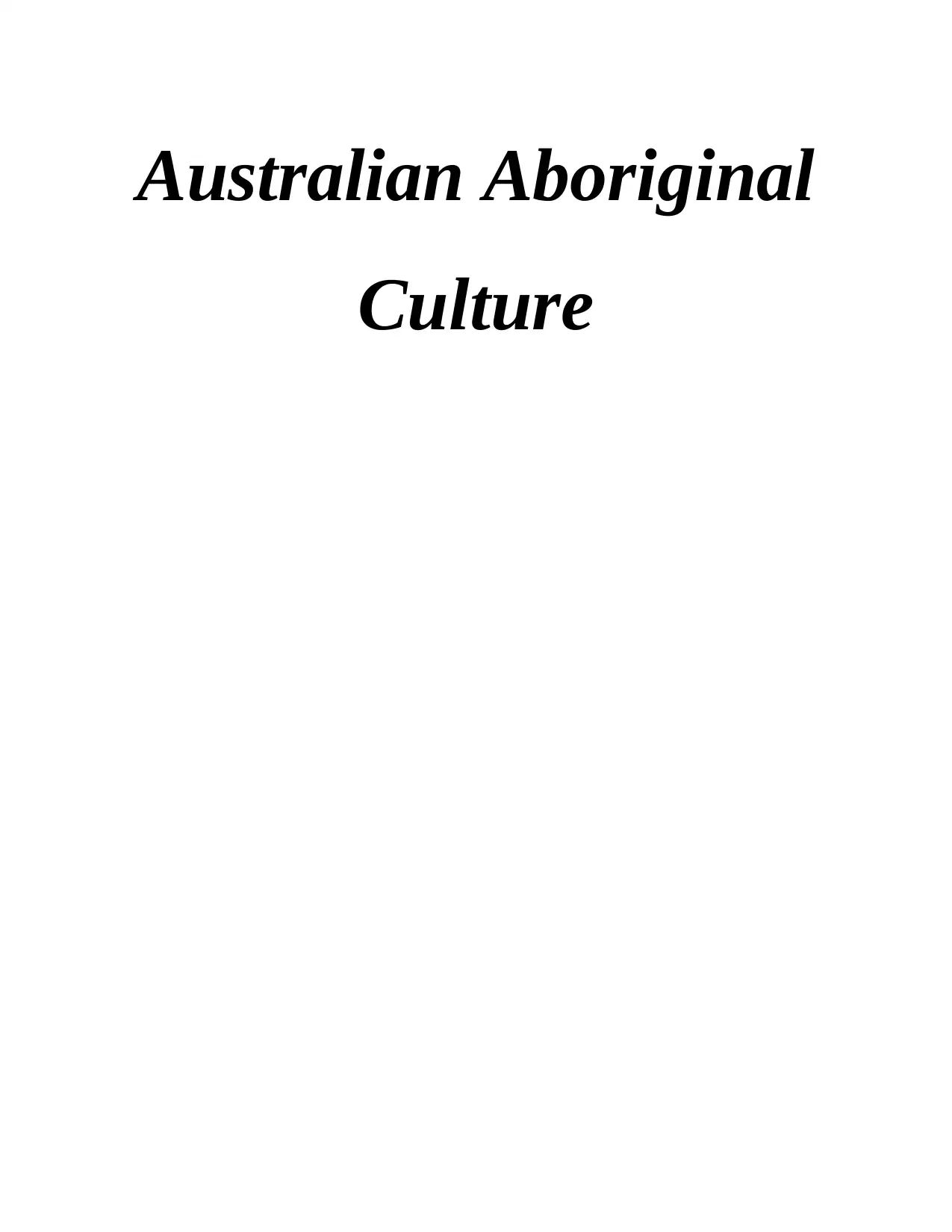
Australian Aboriginal
Culture
Culture
Paraphrase This Document
Need a fresh take? Get an instant paraphrase of this document with our AI Paraphraser

TABLE OF CONTENTS
INTRODUCTION...........................................................................................................................1
Comparative analysis on the aboriginal culture and Indian culture ................................................1
The Seven Dimensions of Culture..............................................................................................1
Hofstede's Six Cultural dimensions ...........................................................................................2
CONCLUSION................................................................................................................................5
REFERENCES................................................................................................................................6
INTRODUCTION...........................................................................................................................1
Comparative analysis on the aboriginal culture and Indian culture ................................................1
The Seven Dimensions of Culture..............................................................................................1
Hofstede's Six Cultural dimensions ...........................................................................................2
CONCLUSION................................................................................................................................5
REFERENCES................................................................................................................................6
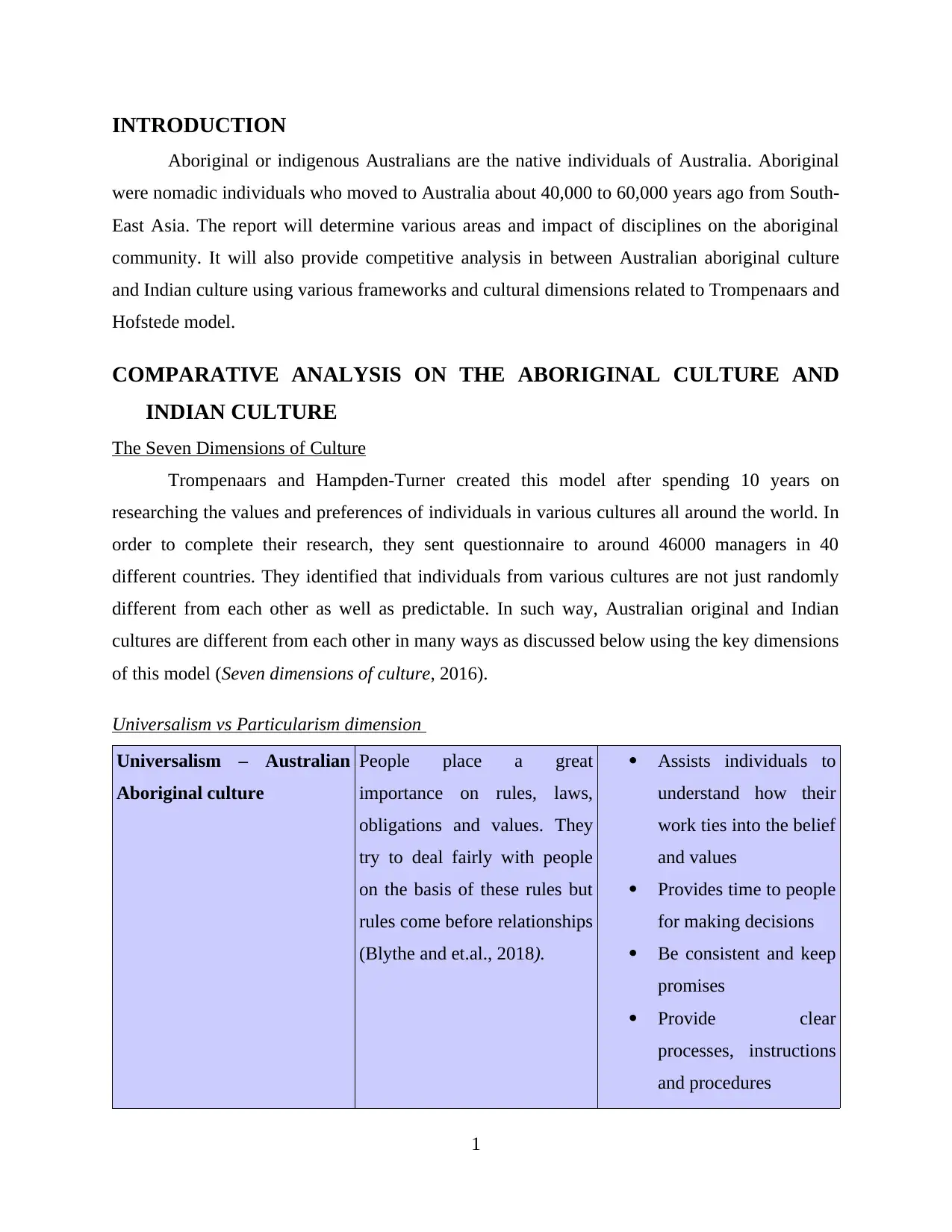
INTRODUCTION
Aboriginal or indigenous Australians are the native individuals of Australia. Aboriginal
were nomadic individuals who moved to Australia about 40,000 to 60,000 years ago from South-
East Asia. The report will determine various areas and impact of disciplines on the aboriginal
community. It will also provide competitive analysis in between Australian aboriginal culture
and Indian culture using various frameworks and cultural dimensions related to Trompenaars and
Hofstede model.
COMPARATIVE ANALYSIS ON THE ABORIGINAL CULTURE AND
INDIAN CULTURE
The Seven Dimensions of Culture
Trompenaars and Hampden-Turner created this model after spending 10 years on
researching the values and preferences of individuals in various cultures all around the world. In
order to complete their research, they sent questionnaire to around 46000 managers in 40
different countries. They identified that individuals from various cultures are not just randomly
different from each other as well as predictable. In such way, Australian original and Indian
cultures are different from each other in many ways as discussed below using the key dimensions
of this model (Seven dimensions of culture, 2016).
Universalism vs Particularism dimension
Universalism – Australian
Aboriginal culture
People place a great
importance on rules, laws,
obligations and values. They
try to deal fairly with people
on the basis of these rules but
rules come before relationships
(Blythe and et.al., 2018).
Assists individuals to
understand how their
work ties into the belief
and values
Provides time to people
for making decisions
Be consistent and keep
promises
Provide clear
processes, instructions
and procedures
1
Aboriginal or indigenous Australians are the native individuals of Australia. Aboriginal
were nomadic individuals who moved to Australia about 40,000 to 60,000 years ago from South-
East Asia. The report will determine various areas and impact of disciplines on the aboriginal
community. It will also provide competitive analysis in between Australian aboriginal culture
and Indian culture using various frameworks and cultural dimensions related to Trompenaars and
Hofstede model.
COMPARATIVE ANALYSIS ON THE ABORIGINAL CULTURE AND
INDIAN CULTURE
The Seven Dimensions of Culture
Trompenaars and Hampden-Turner created this model after spending 10 years on
researching the values and preferences of individuals in various cultures all around the world. In
order to complete their research, they sent questionnaire to around 46000 managers in 40
different countries. They identified that individuals from various cultures are not just randomly
different from each other as well as predictable. In such way, Australian original and Indian
cultures are different from each other in many ways as discussed below using the key dimensions
of this model (Seven dimensions of culture, 2016).
Universalism vs Particularism dimension
Universalism – Australian
Aboriginal culture
People place a great
importance on rules, laws,
obligations and values. They
try to deal fairly with people
on the basis of these rules but
rules come before relationships
(Blythe and et.al., 2018).
Assists individuals to
understand how their
work ties into the belief
and values
Provides time to people
for making decisions
Be consistent and keep
promises
Provide clear
processes, instructions
and procedures
1
⊘ This is a preview!⊘
Do you want full access?
Subscribe today to unlock all pages.

Trusted by 1+ million students worldwide
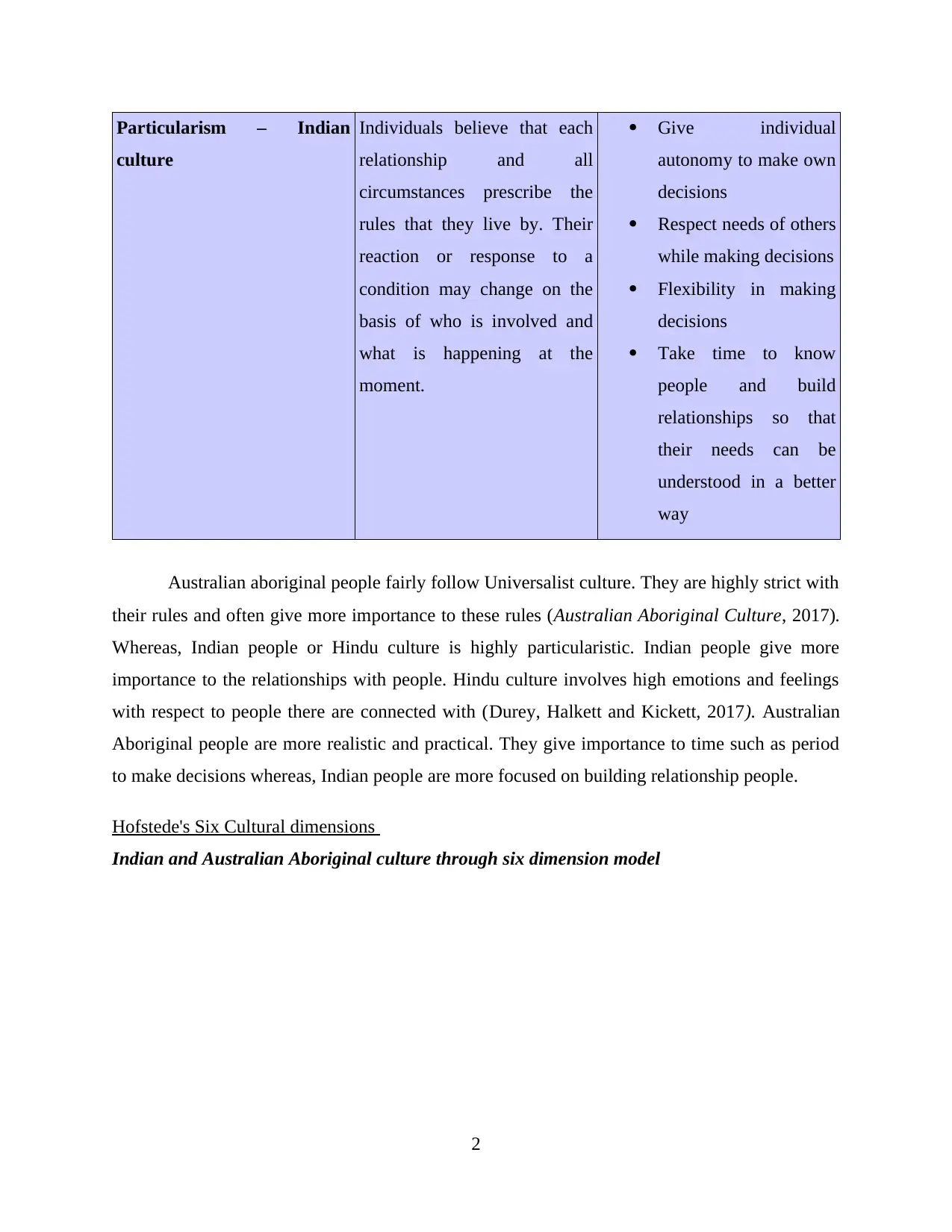
Particularism – Indian
culture
Individuals believe that each
relationship and all
circumstances prescribe the
rules that they live by. Their
reaction or response to a
condition may change on the
basis of who is involved and
what is happening at the
moment.
Give individual
autonomy to make own
decisions
Respect needs of others
while making decisions
Flexibility in making
decisions
Take time to know
people and build
relationships so that
their needs can be
understood in a better
way
Australian aboriginal people fairly follow Universalist culture. They are highly strict with
their rules and often give more importance to these rules (Australian Aboriginal Culture, 2017).
Whereas, Indian people or Hindu culture is highly particularistic. Indian people give more
importance to the relationships with people. Hindu culture involves high emotions and feelings
with respect to people there are connected with (Durey, Halkett and Kickett, 2017). Australian
Aboriginal people are more realistic and practical. They give importance to time such as period
to make decisions whereas, Indian people are more focused on building relationship people.
Hofstede's Six Cultural dimensions
Indian and Australian Aboriginal culture through six dimension model
2
culture
Individuals believe that each
relationship and all
circumstances prescribe the
rules that they live by. Their
reaction or response to a
condition may change on the
basis of who is involved and
what is happening at the
moment.
Give individual
autonomy to make own
decisions
Respect needs of others
while making decisions
Flexibility in making
decisions
Take time to know
people and build
relationships so that
their needs can be
understood in a better
way
Australian aboriginal people fairly follow Universalist culture. They are highly strict with
their rules and often give more importance to these rules (Australian Aboriginal Culture, 2017).
Whereas, Indian people or Hindu culture is highly particularistic. Indian people give more
importance to the relationships with people. Hindu culture involves high emotions and feelings
with respect to people there are connected with (Durey, Halkett and Kickett, 2017). Australian
Aboriginal people are more realistic and practical. They give importance to time such as period
to make decisions whereas, Indian people are more focused on building relationship people.
Hofstede's Six Cultural dimensions
Indian and Australian Aboriginal culture through six dimension model
2
Paraphrase This Document
Need a fresh take? Get an instant paraphrase of this document with our AI Paraphraser
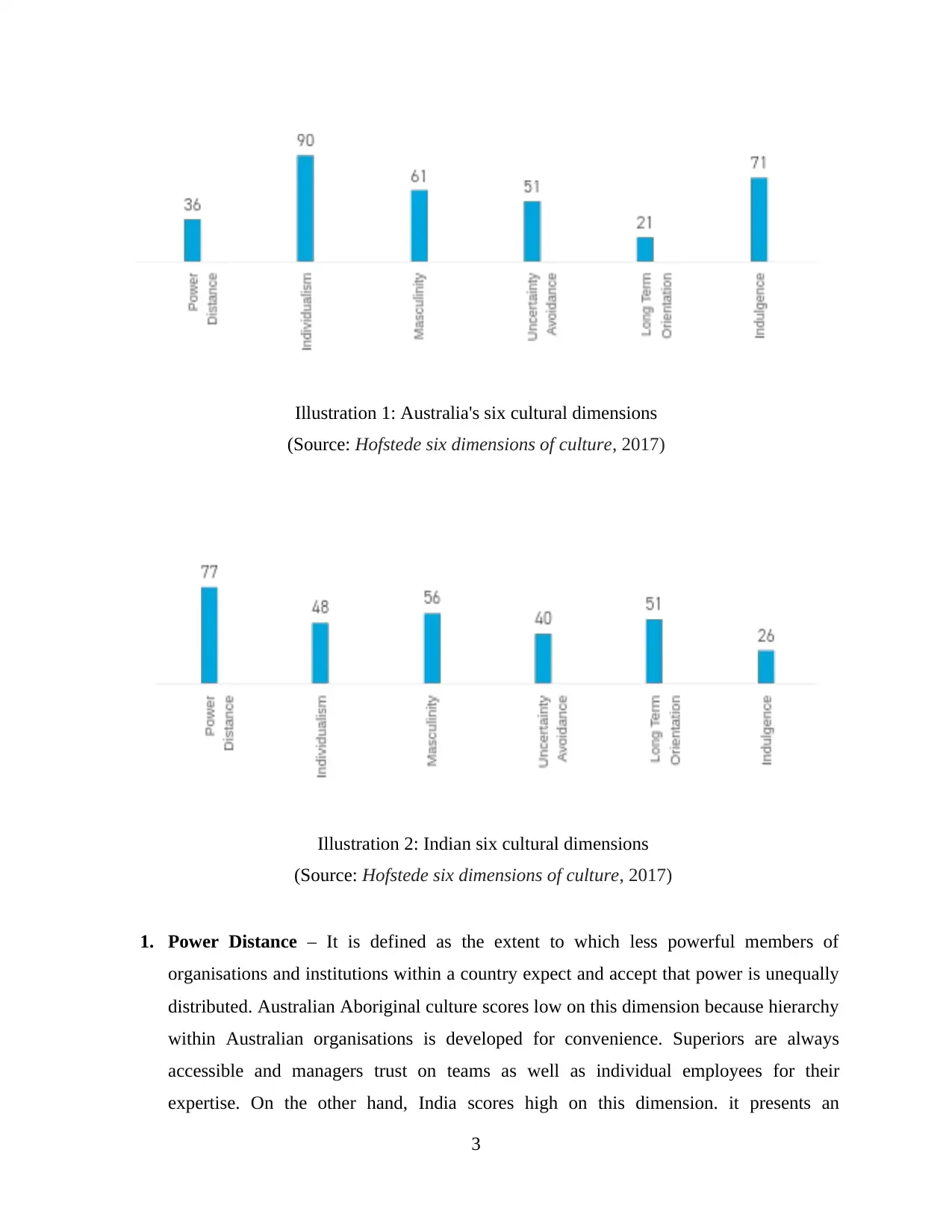
1. Power Distance – It is defined as the extent to which less powerful members of
organisations and institutions within a country expect and accept that power is unequally
distributed. Australian Aboriginal culture scores low on this dimension because hierarchy
within Australian organisations is developed for convenience. Superiors are always
accessible and managers trust on teams as well as individual employees for their
expertise. On the other hand, India scores high on this dimension. it presents an
3
Illustration 1: Australia's six cultural dimensions
(Source: Hofstede six dimensions of culture, 2017)
Illustration 2: Indian six cultural dimensions
(Source: Hofstede six dimensions of culture, 2017)
organisations and institutions within a country expect and accept that power is unequally
distributed. Australian Aboriginal culture scores low on this dimension because hierarchy
within Australian organisations is developed for convenience. Superiors are always
accessible and managers trust on teams as well as individual employees for their
expertise. On the other hand, India scores high on this dimension. it presents an
3
Illustration 1: Australia's six cultural dimensions
(Source: Hofstede six dimensions of culture, 2017)
Illustration 2: Indian six cultural dimensions
(Source: Hofstede six dimensions of culture, 2017)
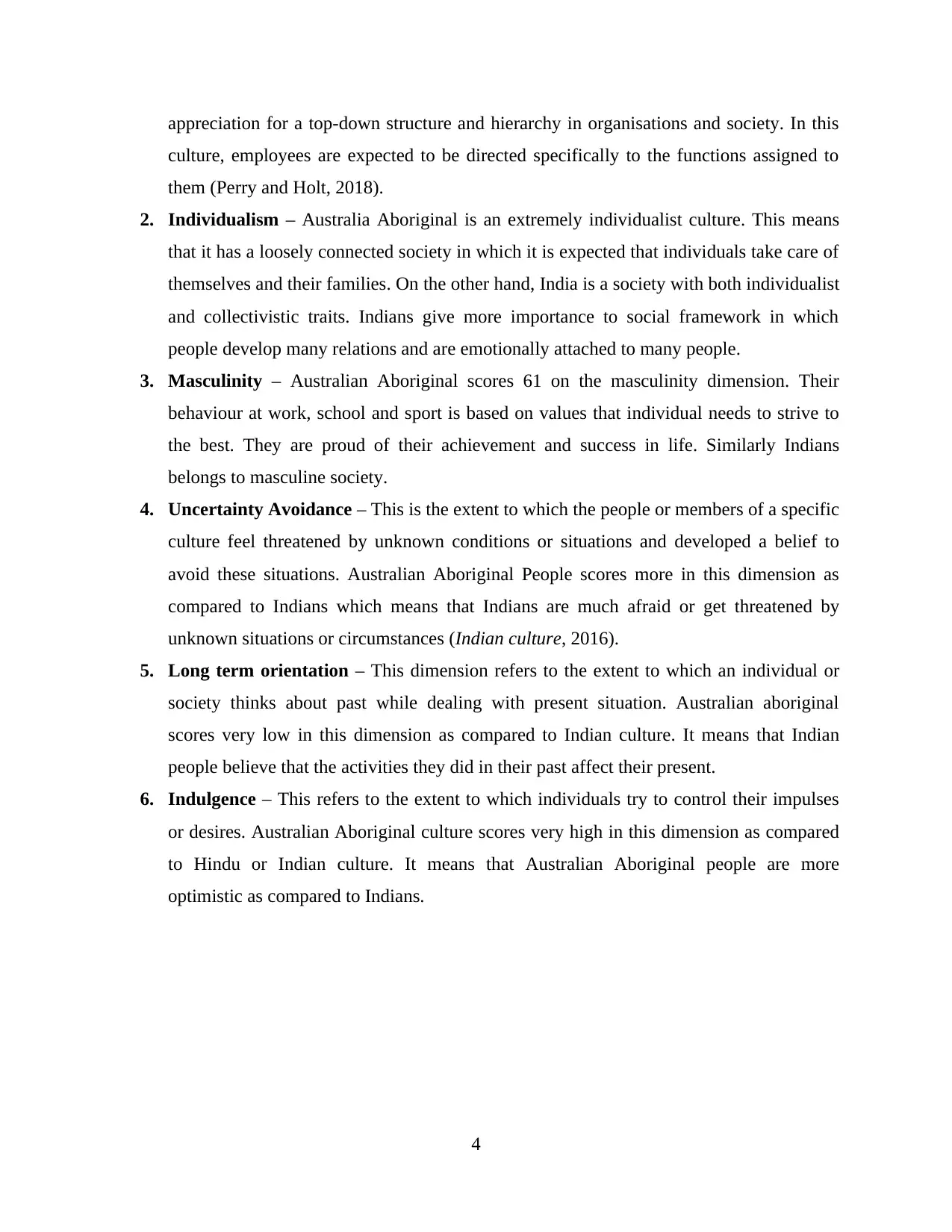
appreciation for a top-down structure and hierarchy in organisations and society. In this
culture, employees are expected to be directed specifically to the functions assigned to
them (Perry and Holt, 2018).
2. Individualism – Australia Aboriginal is an extremely individualist culture. This means
that it has a loosely connected society in which it is expected that individuals take care of
themselves and their families. On the other hand, India is a society with both individualist
and collectivistic traits. Indians give more importance to social framework in which
people develop many relations and are emotionally attached to many people.
3. Masculinity – Australian Aboriginal scores 61 on the masculinity dimension. Their
behaviour at work, school and sport is based on values that individual needs to strive to
the best. They are proud of their achievement and success in life. Similarly Indians
belongs to masculine society.
4. Uncertainty Avoidance – This is the extent to which the people or members of a specific
culture feel threatened by unknown conditions or situations and developed a belief to
avoid these situations. Australian Aboriginal People scores more in this dimension as
compared to Indians which means that Indians are much afraid or get threatened by
unknown situations or circumstances (Indian culture, 2016).
5. Long term orientation – This dimension refers to the extent to which an individual or
society thinks about past while dealing with present situation. Australian aboriginal
scores very low in this dimension as compared to Indian culture. It means that Indian
people believe that the activities they did in their past affect their present.
6. Indulgence – This refers to the extent to which individuals try to control their impulses
or desires. Australian Aboriginal culture scores very high in this dimension as compared
to Hindu or Indian culture. It means that Australian Aboriginal people are more
optimistic as compared to Indians.
4
culture, employees are expected to be directed specifically to the functions assigned to
them (Perry and Holt, 2018).
2. Individualism – Australia Aboriginal is an extremely individualist culture. This means
that it has a loosely connected society in which it is expected that individuals take care of
themselves and their families. On the other hand, India is a society with both individualist
and collectivistic traits. Indians give more importance to social framework in which
people develop many relations and are emotionally attached to many people.
3. Masculinity – Australian Aboriginal scores 61 on the masculinity dimension. Their
behaviour at work, school and sport is based on values that individual needs to strive to
the best. They are proud of their achievement and success in life. Similarly Indians
belongs to masculine society.
4. Uncertainty Avoidance – This is the extent to which the people or members of a specific
culture feel threatened by unknown conditions or situations and developed a belief to
avoid these situations. Australian Aboriginal People scores more in this dimension as
compared to Indians which means that Indians are much afraid or get threatened by
unknown situations or circumstances (Indian culture, 2016).
5. Long term orientation – This dimension refers to the extent to which an individual or
society thinks about past while dealing with present situation. Australian aboriginal
scores very low in this dimension as compared to Indian culture. It means that Indian
people believe that the activities they did in their past affect their present.
6. Indulgence – This refers to the extent to which individuals try to control their impulses
or desires. Australian Aboriginal culture scores very high in this dimension as compared
to Hindu or Indian culture. It means that Australian Aboriginal people are more
optimistic as compared to Indians.
4
⊘ This is a preview!⊘
Do you want full access?
Subscribe today to unlock all pages.

Trusted by 1+ million students worldwide
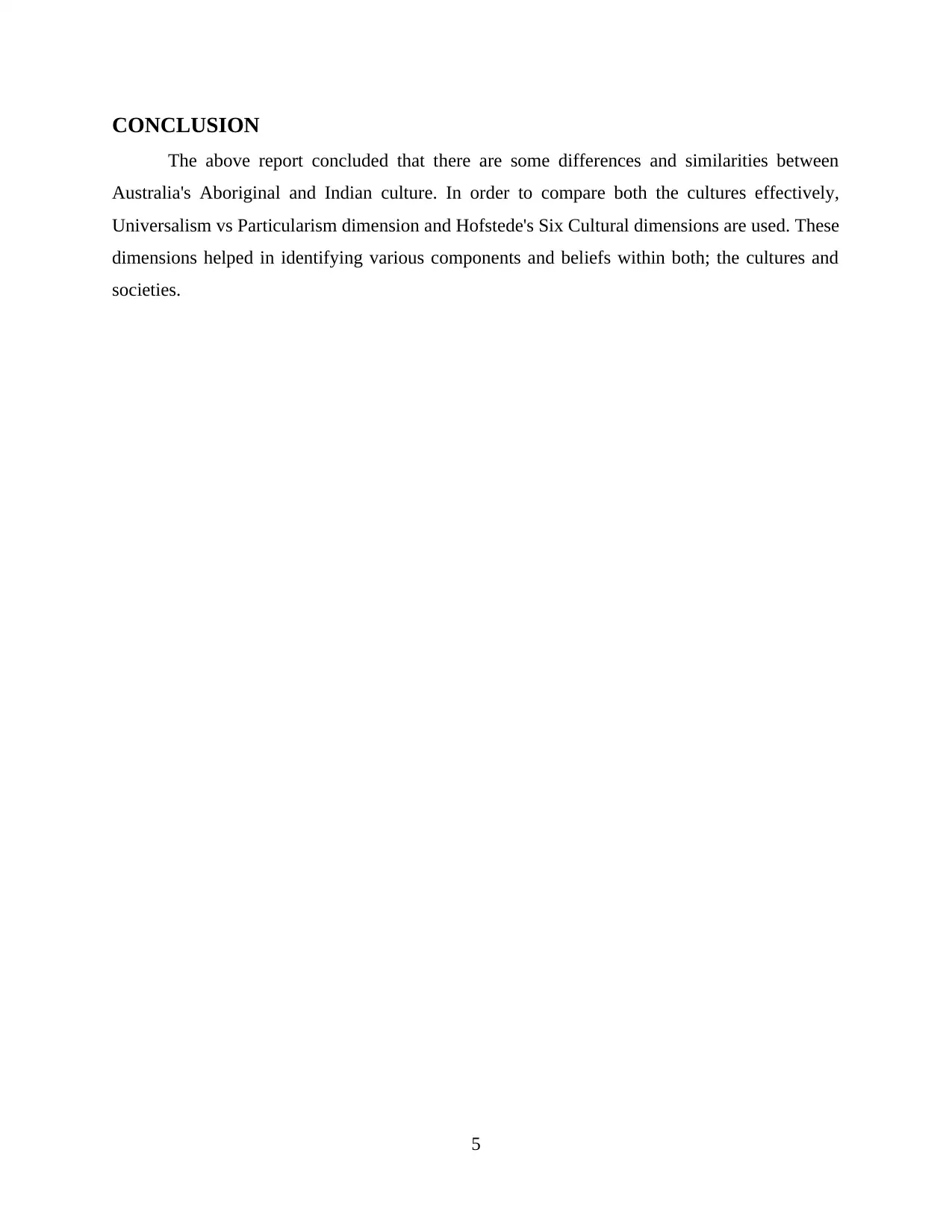
CONCLUSION
The above report concluded that there are some differences and similarities between
Australia's Aboriginal and Indian culture. In order to compare both the cultures effectively,
Universalism vs Particularism dimension and Hofstede's Six Cultural dimensions are used. These
dimensions helped in identifying various components and beliefs within both; the cultures and
societies.
5
The above report concluded that there are some differences and similarities between
Australia's Aboriginal and Indian culture. In order to compare both the cultures effectively,
Universalism vs Particularism dimension and Hofstede's Six Cultural dimensions are used. These
dimensions helped in identifying various components and beliefs within both; the cultures and
societies.
5
Paraphrase This Document
Need a fresh take? Get an instant paraphrase of this document with our AI Paraphraser
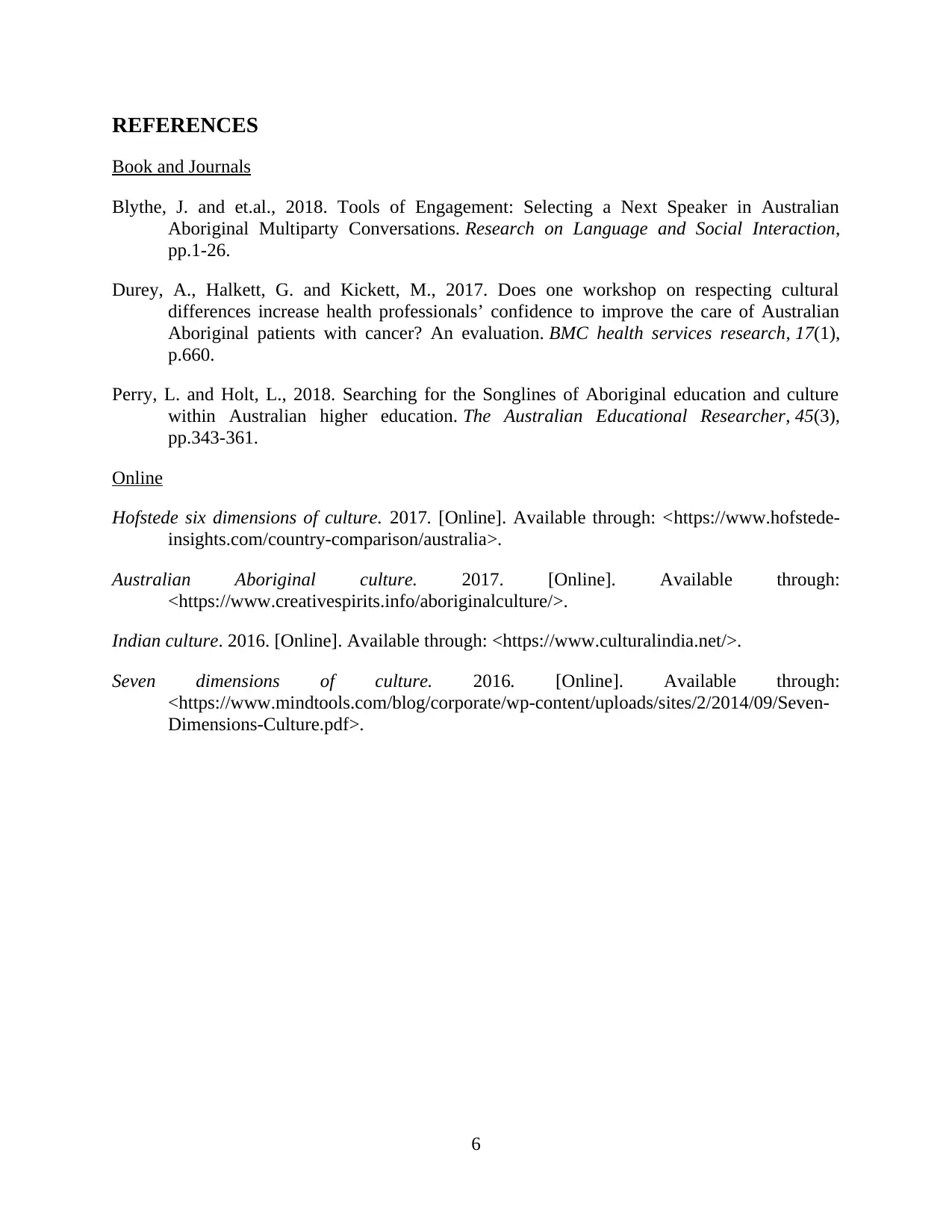
REFERENCES
Book and Journals
Blythe, J. and et.al., 2018. Tools of Engagement: Selecting a Next Speaker in Australian
Aboriginal Multiparty Conversations. Research on Language and Social Interaction,
pp.1-26.
Durey, A., Halkett, G. and Kickett, M., 2017. Does one workshop on respecting cultural
differences increase health professionals’ confidence to improve the care of Australian
Aboriginal patients with cancer? An evaluation. BMC health services research, 17(1),
p.660.
Perry, L. and Holt, L., 2018. Searching for the Songlines of Aboriginal education and culture
within Australian higher education. The Australian Educational Researcher, 45(3),
pp.343-361.
Online
Hofstede six dimensions of culture. 2017. [Online]. Available through: <https://www.hofstede-
insights.com/country-comparison/australia>.
Australian Aboriginal culture. 2017. [Online]. Available through:
<https://www.creativespirits.info/aboriginalculture/>.
Indian culture. 2016. [Online]. Available through: <https://www.culturalindia.net/>.
Seven dimensions of culture. 2016. [Online]. Available through:
<https://www.mindtools.com/blog/corporate/wp-content/uploads/sites/2/2014/09/Seven-
Dimensions-Culture.pdf>.
6
Book and Journals
Blythe, J. and et.al., 2018. Tools of Engagement: Selecting a Next Speaker in Australian
Aboriginal Multiparty Conversations. Research on Language and Social Interaction,
pp.1-26.
Durey, A., Halkett, G. and Kickett, M., 2017. Does one workshop on respecting cultural
differences increase health professionals’ confidence to improve the care of Australian
Aboriginal patients with cancer? An evaluation. BMC health services research, 17(1),
p.660.
Perry, L. and Holt, L., 2018. Searching for the Songlines of Aboriginal education and culture
within Australian higher education. The Australian Educational Researcher, 45(3),
pp.343-361.
Online
Hofstede six dimensions of culture. 2017. [Online]. Available through: <https://www.hofstede-
insights.com/country-comparison/australia>.
Australian Aboriginal culture. 2017. [Online]. Available through:
<https://www.creativespirits.info/aboriginalculture/>.
Indian culture. 2016. [Online]. Available through: <https://www.culturalindia.net/>.
Seven dimensions of culture. 2016. [Online]. Available through:
<https://www.mindtools.com/blog/corporate/wp-content/uploads/sites/2/2014/09/Seven-
Dimensions-Culture.pdf>.
6
1 out of 8
Related Documents
Your All-in-One AI-Powered Toolkit for Academic Success.
+13062052269
info@desklib.com
Available 24*7 on WhatsApp / Email
![[object Object]](/_next/static/media/star-bottom.7253800d.svg)
Unlock your academic potential
Copyright © 2020–2025 A2Z Services. All Rights Reserved. Developed and managed by ZUCOL.



